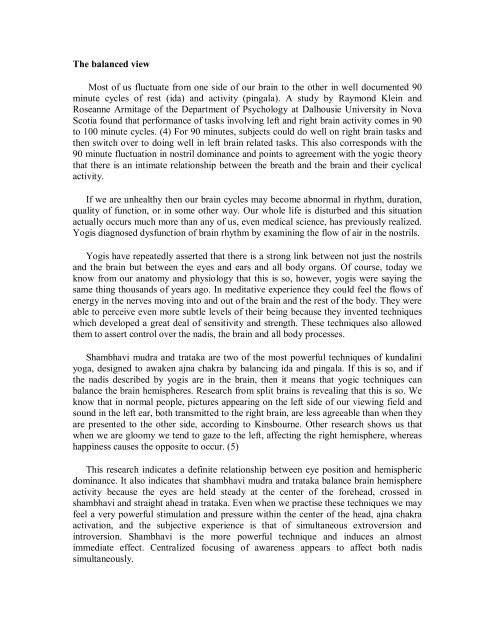Kundalini.Tantra.by.Satyananda.Saraswati
You also want an ePaper? Increase the reach of your titles
YUMPU automatically turns print PDFs into web optimized ePapers that Google loves.
The balanced view<br />
Most of us fluctuate from one side of our brain to the other in well documented 90<br />
minute cycles of rest (ida) and activity (pingala). A study <strong>by</strong> Raymond Klein and<br />
Roseanne Armitage of the Department of Psychology at Dalhousie University in Nova<br />
Scotia found that performance of tasks involving left and right brain activity comes in 90<br />
to 100 minute cycles. (4) For 90 minutes, subjects could do well on right brain tasks and<br />
then switch over to doing well in left brain related tasks. This also corresponds with the<br />
90 minute fluctuation in nostril dominance and points to agreement with the yogic theory<br />
that there is an intimate relationship between the breath and the brain and their cyclical<br />
activity.<br />
If we are unhealthy then our brain cycles may become abnormal in rhythm, duration,<br />
quality of function, or in some other way. Our whole life is disturbed and this situation<br />
actually occurs much more than any of us, even medical science, has previously realized.<br />
Yogis diagnosed dysfunction of brain rhythm <strong>by</strong> examining the flow of air in the nostrils.<br />
Yogis have repeatedly asserted that there is a strong link between not just the nostrils<br />
and the brain but between the eyes and ears and all body organs. Of course, today we<br />
know from our anatomy and physiology that this is so, however, yogis were saying the<br />
same thing thousands of years ago. In meditative experience they could feel the flows of<br />
energy in the nerves moving into and out of the brain and the rest of the body. They were<br />
able to perceive even more subtle levels of their being because they invented techniques<br />
which developed a great deal of sensitivity and strength. These techniques also allowed<br />
them to assert control over the nadis, the brain and all body processes.<br />
Shambhavi mudra and trataka are two of the most powerful techniques of kundalini<br />
yoga, designed to awaken ajna chakra <strong>by</strong> balancing ida and pingala. If this is so, and if<br />
the nadis described <strong>by</strong> yogis are in the brain, then it means that yogic techniques can<br />
balance the brain hemispheres. Research from split brains is revealing that this is so. We<br />
know that in normal people, pictures appearing on the left side of our viewing field and<br />
sound in the left ear, both transmitted to the right brain, are less agreeable than when they<br />
are presented to the other side, according to Kinsbourne. Other research shows us that<br />
when we are gloomy we tend to gaze to the left, affecting the right hemisphere, whereas<br />
happiness causes the opposite to occur. (5)<br />
This research indicates a definite relationship between eye position and hemispheric<br />
dominance. It also indicates that shambhavi mudra and trataka balance brain hemisphere<br />
activity because the eyes are held steady at the center of the forehead, crossed in<br />
shambhavi and straight ahead in trataka. Even when we practise these techniques we may<br />
feel a very powerful stimulation and pressure within the center of the head, ajna chakra<br />
activation, and the subjective experience is that of simultaneous extroversion and<br />
introversion. Shambhavi is the more powerful technique and induces an almost<br />
immediate effect. Centralized focusing of awareness appears to affect both nadis<br />
simultaneously.














![[Lonely Planet] Sri Lanka](https://img.yumpu.com/59845622/1/169x260/lonely-planet-sri-lanka.jpg?quality=85)


